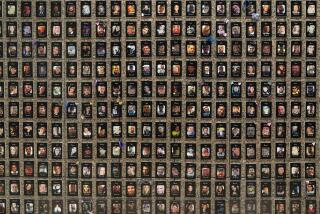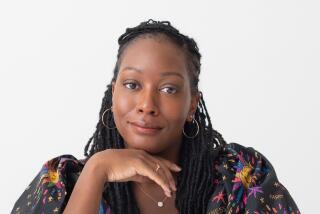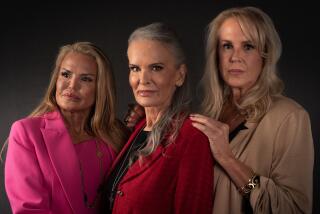The Forgotten Victims : Every year at least 3 million American children witness the battering or killing of one of their parents. They rarely get over the trauma.
They are the invisible victims--peering eyes and straining ears--watching and listening in horror to the kicks and punches and shouts. They are the children who witness one parent brutalizing another.
Usually it is a father savaging a mother with fists or words or both. Usually it is a mess--loud, ugly and vulgar. Sometimes there is blood. Always there is unfathomable anger.
Every year at least 3 million American children 3 to 17 are exposed to this at-home violence, according to Richard Gellis, a University of Rhode Island professor who has spent 25 years researching domestic violence. This sometimes daily shattering of the family order is a betrayal by the very people they depend on for security. Most kids never recover.
Last year, 1,421 women died at the hands of their husbands or partners, Gellis says. In three-quarters of those cases, a child was watching.
The children of O.J. and Nicole Brown Simpson have been out of the public eye for the six weeks since their mother was murdered and their father accused of the crime.
Sydney, 9, and Justin, 6, who were supposedly asleep during the fatal attack, are coping well, according to family reports.
But if reports of domestic violence in the Simpson household are true, these children, like others in similar situations, may face problems in the future.
At least they have the means to get counseling. Most kids don’t have a chance to unravel the complicated trauma that results from observing violence. Instead they must spend years under the specter of a violent father and demoralized mother.
The experts--psychologists, researchers, sociologists and child advocates--fault “the system” for not rescuing these children.
There are shelters and programs to protect battered women; the legal system is supposed to chase the battering man. But unless children are themselves abused, they are frequently left to shuffle behind a shellshocked mother on her road to assistance or simply live amid violence.
“When people rush in to help a family caught up in violence, the children are too often forgotten, “ says Deanne Tilton Durfee, executive director of the Los Angeles County Inter-Agency Council on Child Abuse and Neglect. There may be action to remove custody of the children from the father, but across the country there will be no special attention to their emotional needs, adds Durfee, who is also chair of the U.S. Advisory Board on Child Abuse.
“In L.A. County, we are just beginning to put together a list of therapists and grief counselors,” she says. “But I fear for all those children quietly living a lie.”
In part, the problem is that laws involving child abuse, battered women and child abduction evolved separately during the late 1970s and 1980s. And advocates for the various groups often compete for the same government dollars, which means children’s needs often are lost in the competitive shuffle.
“These problems are all of a piece but unfortunately the laws were all made like chopped liver,” says Kathryn Turman, a child advocate in Virginia working for a nonprofit group there. “If legislators would give up their committee chairmanships and work together, we could have a coherent strategy to help kids.”
In an experimental program to coordinate services for victimized children in the Tampa, Fla., area, police are being trained to at least be aware if there are children home when they respond to domestic abuse calls.
“Cops are among the few public officials to regularly make house calls,” Turman says. “They should know if there are kids home.”
*
Turman went along with two sheriff’s deputies responding to a beating complaint. The deputies, who had been to this home several times, said they didn’t know if the couple had children. This time, while one deputy was subduing the fuming man, the other noticed a spelling book on a coffee table and began to search. Finally, in the master bedroom, she heard a noise coming from the closet. Inside, three small children were huddled together. The older brother had a gun. Whenever a fight broke out, he would grab the gun and hide the other children.
“The Tampa police, the sheriff’s department, any number of people had been in that house without paying any attention to those kids,” Turman says.
As part of this project a new question was added to the police incident report: “Is a Child Present?” If that box is checked, several other questions are asked and the information about the children is fed into a computer that draws reports from other agencies that deal with children.
“The ultimate goal is to identify kids who are victims of abuse or maltreatment and deal with them,” Turman says.
About half the children who witness their mothers being beaten are also abused themselves, numerous studies confirm. But Gellis says it’s actually much worse for the children to watch abuse than to receive it.
“The learning experience is stronger,” he says. “There are more suicide attempts, more dysfunction in school, more likelihood of violence later in life, more withdrawal. More everything.”
Witnessing domestic violence affects children of different ages in different ways. The problems can start in the womb.
Several studies suggest that mothers who report high levels of stress during pregnancy, such as from violence, tend to have babies who are hyperactive and developmentally delayed. Very young children often have the worst physical reactions. One psychologist recalled treating a toddler who would spontaneously get diarrhea every time his parents started fighting. More typically the younger children exhibit a type of social autism: They speak very little, show self-destructive behavior, cling to their caretakers and suffer short-term depression, sleep disorders and heavy separation anxiety.
Gellis says he has seen children as young as 4 show signs of post-traumatic stress syndrome, usually associated with rape victims or Vietnam veterans. “It’s very scary to see this in one so young,” he says.
Older children and teen-agers tend to try to get in between their parents in what has been dubbed “the Bill Clinton phenomenon.” As a young teen, Clinton reportedly stood up to his mother’s second husband several times, but on one pivotal occasion in 1960 grabbed his stepfather by the arm, looked him in the eye and said “Hear me. Never ever touch my mother again.”
Such a dramatic stand can be physically risky, but sometimes the child is emboldened by an emotional need to make things “right.”
*
The children who seem to suffer the most are ages 5 to 10, according to most experts. They know what’s going on but they’re too little and too weak to do anything about it. They experience hopelessness and sometimes thoughts of suicide; they often get headaches and stomachaches; they can become utterly passive and numb, or uncontrollably violent.
To recover, a child needs careful counseling--or at least a special relationship with an empathetic person.
“Bill Clinton talks about his grandmother,” Gellis says. “She was his anchor. But it didn’t work for young Roger (who is 10 years younger). He is, as we in the profession call it, the ‘clinical symptom carrier’ for that household. He was the troubled one.” Roger Clinton, according to a biography by his mother Virginia Kelley, lost his anchor when older brother Bill went away to school and he was left alone to witness his father’s drunken rages against his mother.
Whatever the age of the child, the solutions are the same: therapy, a mother who gets help for herself, a caretaker who is nurturing, sympathetic day care and schools that offer a stable environment.
The challenge for school officials and day-care workers is often excavating the truth about what’s going on at home. One barrier is that it’s just so embarrassing and confusing to children that their parents’ anger can escalate out of control.
Betsy McAlister Groves, a social worker in Boston City Hospital’s Children Witness to Violence project, says she treated a 7-year-old boy who one week described horrific scenes between his parents and how angry he was at his father. Oddly, though, the very next week he talked about what his father did well.
“Children are very loyal--particularly the young ones who, in terms of their moral development, believe might makes right,” Groves says. “This little boy had to be told that his father could both be good and bad.”
She says that so many of these children walk around with an overwhelming sense of shame that as they grow older, they believe they are defective people.
While these child witnesses have a greater chance of being in violent relationships--about 40% repeat the behavior of their parents--as many are in danger of becoming numb, desensitized adults who have no relationships at all.
Turman and others believe that the movement in family courts to keep families together at all costs is based on a myth that enough therapy can make the violence and pain go away. Instead, these people believe that the best thing for the children is to get them away from the violent parent.
“Only a certain proportion of families can be fixed,” Turman says. “Do we have three or four or five years to experiment with a family? Not when the children are being damaged.”
In fact, it’s not unusual for children traumatized by domestic violence to cope well initially--to make it through school and college and to get jobs--but then later experience depression and other symptoms.
*
At 42, Barbara Corry runs a private consulting company in Alhambra to educate groups about domestic abuse. But telling her life story is her real work. For it provides compelling testimony of the ugly legacy of domestic abuse.
After all the therapy, after all her studying to earn a master’s degree in sociology, after all the work to unravel her ugly past, Corry’s voice still shakes at the mention of what she survived.
“When I came along I was supposed to make things better,” she says in a phone interview. “But all my birth did was bring another person into a not-good situation.
Corry says her father was an alcoholic who would return home from work drunk two and three times a week and scream at her mother. He would charge at her with a fist in her face; yell at her; keep her awake for hours raging that the lettuce on his sandwich was limp or that she hadn’t sewn his shirt right. Once or twice he punched her, but mostly he restrained himself physically--which only seemed to increase the intensity of his verbal abuse.
“My mother was raised very traditionally, so when she couldn’t take it anymore she went to see the priest,” says Corry, referring to a time before she was born and her brother was 7. “The priest told her to pray for my father and try to be a better wife. He instructed her to have another baby to make things better.”
As Corry got a little older, she would try to intervene between her parents.
“My cries and my pleas would distract my father or somehow cut the circuits. But it never stopped him.”
When her older brother was 16, he got into a fistfight with his father and was sent to live with an uncle in Indiana. “I didn’t want to be sent away,” Corry says. “My strategy was to shrink back and to be sweet and cute.”
As Corry describes her family during an interview, she keeps switching into the third person as if to distance herself from such a horrific tale.
“My anger was directed inward,” she continues. “I developed a serious eating disorder. I was very shutdown, you know, on automatic pilot. I think I was stuffing anger, stuffing pain, stuffing myself.”
She didn’t move away from home until she was 25 and received counseling after that. But her brother and mother died--he of AIDS, she of cancer--before they could get any emotional help.
Corry, who moved to Los Angeles 12 years ago, wrote her father a long letter explaining her feelings. He never wrote back. Their only contact is a Christmas card each year. “Hope all is well,” says the card. “Love, Dad.”
As she describes the card, Corry chokes and starts talking clinically about “people who are that monstrous.” Later she explains that although she has conquered her compulsive eating problems and made great strides in understanding her family, she has been unable to have a relationship of her own.
“I saw that it is possible to devastate a person’s personality and spirit,” she says, her voice again halting and shaky. “You’ve got to prove to me you’re not a (jerk) before I get involved. It’s all terror-based.”
More to Read
Sign up for Essential California
The most important California stories and recommendations in your inbox every morning.
You may occasionally receive promotional content from the Los Angeles Times.










